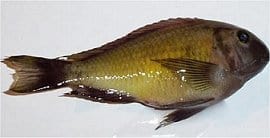It is quite common now for Tropheus to contract bloat disease, this is more common in wild Tropheus due to their being moved to unnatural surroundings however is becoming more so common in non wild caught Tropheus now too. This is not to be confused with normal cichlid bloat although it is very similar.
The disease has similar stages to 4 stages in cichlid bloat which are:
- Fish hides a lot and doesn’t swim around much, it is also not keen at feeding time and if any food is taken in the mouth it is spat back out again.
- The affected cichlid may be appearing to exhale excessively and could almost be likened to coughing.
- The excrement appears to be white in colour and is very long and hangs from the fish for hours.
- The fish will swell up, often to twice the original size and death will shortly follow after this stage although can die before it reaches this stage.
It has a high mortality rate although isn’t as infectious as normal cichlid bloat. It is still advisable to use a hospital tank though and isolate the fish so that unnecessary treatment isn’t carried out on unaffected fish and so the cost of treating the fish is lower due to only having to treat a smaller volume of water.

It is thought that the only effective treatment to cure Tropheus bloat is a combination of metronidazole/dimetridazole and an antibiotic. Effective medicines are those which contain nifurpirinol, such as Bio Furan and Aqua Furan. It is also a good idea to use table salt too (200 grams per 100 litres of water). Over dosing of a source of metronidazole such as Octozin by Waterlife can lead to positive results and although the fish may appear cured after a few days/a week. The use of these treatments will often leave the fish venerable to a relapse so it is advisable to leave them in isolation for several weeks after treating them to ensure this doesn’t happen.


Related Posts
A Deeper Look In To Loach Fish Species
How Much Salt Should I Add To My Freshwater Aquarium
Everything You Need To Know About Using T5 Lights For Your Aquarium